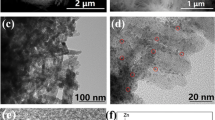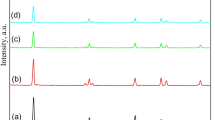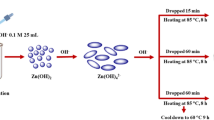Abstract
Fabrication of mesoporous ZnO nanorods photocatalysts exploiting a facile one-pot regime of zinc methoxide and F127 triblock copolymer as a surfactant was conducted. The impact of decoration with platinum on the photocatalytic efficacy, crystallinity, morphology, and physical aspects of mesoporous Pt@ZnO nanorods accommodating various proportions of Pt was interrogated. TEM micrographs affirmed that the fabricated mesoporous ZnO nanorods displayed nanorods architecture and platinum was doped on the surface of mesoporous ZnO nanorods as dots. The measured lattice spacing of the (002) plane of ZnO was found to be about 0.270 nm, affirming the development of the ZnO lattice architecture. On the other hand, the consistent lattice spacing of the (111) plane of Pt was 0.220 nm, endorsing the progression of the metallic platinum lattice architecture. Evidently, the surface area possessed by the fabricated mesoporous ZnO nanorods was 200 m2/g; up to our knowledge, this large surface area wasn’t attained previously. Furthermore, the average pore diameter and the total pore volume possessed by the fabricated mesoporous ZnO nanorods photocatalyst were 6.90 nm and 0.140 cm3/g, respectively. Ciprofloxacin (CIP) was photocatalytically degraded adopting mesoporous ZnO nanorods photocatalyst with a performance of 10%, whereas the photocatalytic performance toward CIP destruction was enhanced up to 100% upon doping ZnO nanorods photocatalyst with 0.6 wt.% Pt. Also, doping of the mesoporous ZnO nanorods photocatalyst with 0.6 wt.% Pt enhanced the photocatalytic degradation rate by 14 times compared with that of mesoporous ZnO nanorods photocatalyst. This conclusion could be attributed to the development of a high concentration of hydroxyl radicals, the accelerated dissipation of ciprofloxacin molecules to the active centers of the developed photocatalyst in addition to the reduced light scattering owing to the large surface area and high pore volume of the photocatalyst.











Similar content being viewed by others
References
Abdennouri M, Elhalil A, Farnane M, Tounsadi H, Mahjoubi FZ, Elmoubarki R, Sadiq M, Khamar L, Galadi A, Baâlala M, Bensitel M, El Hafiane Y, Smith A, Barka N (2015) Photocatalytic degradation of 2,4-D and 2,4-DP herbicides on Pt/TiO2 nanoparticles. J Saudi Chem Soc 19:485–493
Akhundi A, Habibi-Yangjeh A, Abitorabi M, Rahim Pouran S (2019) Review on photocatalytic conversion of carbon dioxide to value-added compounds and renewable fuels by graphitic carbon nitride-based photocatalysts. Catal Rev 61(4):595–628
An T, Yang H, Li G, Song W, Cooper WJ, Nie X (2010) Kinetics and mechanism of advanced oxidation processes (AOPs) in degradation of ciprofloxacin in water. Appl Catal B 94:288–294
Antonin VS, Santos MC, Garcia-Segura S, Brillas E (2015) Electrochemical incineration of the antibiotic ciprofloxacin in sulfate medium and synthetic urine matrix. Water Res 83:31–41
Baoum AA, Amin MS, Mohamed RM (2018) Decoration of SnO2 nanosheets by AgI nanoparticles driven visible light for norfloxacin degradation. Appl Nanosci 8:2093–2102
Baoum A, Amin MS, Mohamed RM (2020) Development of CuCr2O4 nanocomposite adopting decoration with polyaniline for acridine orange dye degradation. Appl Nanosci 10:1501–1510
Bolong N, Ismail AF, Salim MR, Matsuura T (2009) A review of the effects of emerging contaminants in wastewater and options for their removal. Desalination 239:229–246
Bonakdarpour B, Vyrides I, Stuckey DC (2011) Comparison of the performance of one stage and two stage sequential anaerobic–aerobic biological processes for the treatment of reactive-azo-dye-containing synthetic wastewaters. Int Biodeterior Biodegrad 65:591–599
Bousslama W, Elhouichet H, Férid M (2017) Enhanced photocatalytic activity of Fe doped ZnO nanocrystals under sunlight irradiation. Optik 134:88–98
Cai A, Guo A, Du L, Qi Y, Wang X (2018) Leaf-templated synthesis of hierarchical AgCl-Ag-ZnO composites with enhanced visible-light photocatalytic activity. Mater Res Bull 103:225–233
Chakraborty S, Loutatidou S, Palmisano G, Kujawa J, Mavukkandy MO, Al-Gharabli S, Curcio E, Arafat HA (2017) Photocatalytic hollow fiber membranes for the degradation of pharmaceutical compounds in wastewater. J Environ Chem Eng 5:5014–5024
Daneshvar N, Salari D, Khataee AR (2004) Photocatalytic degradation of azo dye acid red 14 in water on ZnO as an alternative catalyst to TiO2. J Photochem Photobiol A Chem 162:317–322
Daughton CG, Ternes TA (1999) Pharmaceuticals and personal care products in the environment: agents of subtle change? Environ Health Perspect 107:907–938
Djurišić AB, Leung YH (2006) Optical properties of ZnO nanostructures. Small 2:944–961
Elhalil A, Tounsadi H, Elmoubarki R, Mahjoubi FZ, Farnane M, Sadiq M, Abdennouri M, Qourzal S, Barka N (2016) Factorial experimental design for the optimization of catalytic degradation of malachite green dye in aqueous solution by Fenton process. Water Resour Ind 15:41–48
Freitas TKFS, Oliveira VM, de Souza MTF, Geraldino HCL, Almeida VC, Fávaro SL, Garcia JC (2015) Optimization of coagulation-flocculation process for treatment of industrial textile wastewater using okra (A. esculentus) mucilage as natural coagulant. Ind Crops Prod 76:538–544
Georgekutty R, Seery MK, Pillai SC (2008) A highly efficient Ag-ZnO photocatalyst: synthesis, properties, and mechanism. J Phys Chem C 112:13563–13570
Hariharan C (2006) Photocatalytic degradation of organic contaminants in water by ZnO nanoparticles: revisited. Appl Catal A Gen 304:55–61
Ismail AA, Mohamed RM, Fouad OA, Ibrahim IA (2006) Synthesis of nanosized ZSM-5 using different alumina sources. Cryst Res Technol 41(2):145–149
Jaramillo-Páez C, Navío JA, Hidalgo MC (2018) Silver-modified ZnO highly UV-photoactive. J Photochem Photobiol A Chem 356:112–122
Jodat A, Jodat A (2014) Photocatalytic degradation of chloramphenicol and tartrazine using Ag/TiO2 nanoparticles. Desalin Water Treat 52:2668–2267
Kansal SK, Singh M, Sud D (2007) Studies on photodegradation of two commercial dyes in aqueous phase using different photocatalysts. J Hazard Mater 141:581–590
Kochuveedu ST, Jang YH, Kim DH (2013) A study on the mechanism for the interaction of light with noble metal-metal oxide semiconductor nanostructures for various photophysical applications. Chem Soc Rev 42:8467–8493
Li X, Liu H, Cheng L, Tong H (2003) Photocatalytic oxidation using a new catalyst TiO2 microspherefor water and wastewater treatment. Environ Sci Technol 37:3989–3994
Lin D, Wu H, Zhang R, Pan W (2009) Enhanced Photocatalysis of electrospun Ag−ZnO heterostructured nanofibers. Chem Mater 21:3479–3484
Liqiang J, Dejun W, Baiqi W, Shudan L, Baifu X, Honggang F, Jiazhong S (2006) Effects of noble metal modification on surface oxygen composition, charge separation and photocatalytic activity of ZnO nanoparticles. J Mol Catal A Chem 244:193–200
Liu Y, Xu C, Zhu Z, Lu J, Manohari AG, Shi Z (2018) Self-assembled ZnO/Ag hollow spheres for effective photocatalysis and bacteriostasis. Mater Res Bull 98:64–69
Ma S, Xue J, Zhou Y, Zhang Z (2014) Photochemical synthesis of ZnO/Ag2O heterostructures with enhanced ultraviolet and visible photocatalytic activity. J Mater Chem A 2:7272–7280
Mahjoubi FZ, Khalidi A, Abdennouri M, Barka N (2016) M-Al-SO4 layered double hydroxides (M=Zn, Mg or Ni): synthesis, characterization and textile dyes removal efficiency. Desalin Water Treat 57:21564–21576
Miyauchi M, Nakajima A, Watanabe T, Hashimoto K (2002) Photocatalysis and photoinduced hydrophilicity of various metal oxide thin films. Chem Mater 14:2812–2816
Mohamed RM (2009) Characterization and catalytic properties of nano-sized Pt metal catalyst on TiO2-SiO2 synthesized by photo-assisted deposition and impregnation methods. J Mater Process Technol 209(1):577–583
Mohamed RM, Aazam E (2013) Synthesis and characterization of P-doped TiO2 thin-films for photocatalytic degradation of butyl benzyl phthalate under visible-light irradiation. Chin J Catal 34(6):1267–1273
Mohamed RM, Salam MA (2014) Photocatalytic reduction of aqueous mercury (II) using multi-walled carbon nanotubes/Pd-ZnO nanocomposite. Mater Res Bull 50:85–90
Mohamed RM, Mkhalid IA, Baeissa ES, Al-Rayyani MA (2012) Photocatalytic degradation of methylene blue by Fe/ZnO/SiO2 nanoparticles under visible light. J Nanotechnol 2012:1–5
Mohamed RM, Shawky A, Mkhalid IA (2017) Facile synthesis of MgO and Ni-MgO nanostructures with enhanced adsorption of methyl blue dye. J Phys Chem Solids 101:50–57
Mu J, Shao C, Guo Z, Zhang Z, Zhang M, Zhang P, Chen B, Liu Y (2011) High photocatalytic activity of ZnO−carbon nanofiber heteroarchitectures. ACS Appl Mater Interfaces 3:590–596
Pirhashemi M, Habibi-Yangjeh A, Pouran SR (2018) Review on the criteria anticipated for the fabrication of highly efficient ZnO-based visible-light-driven photocatalysts. J Ind Eng Chem 62:1–25
Plodinec M, Gajović A, Jakša G, Žagar K, Čeh M (2014) High-temperature hydrogenation of pure and silver-decorated titanate nanotubes to increase their solar absorbance for photocatalytic applications. J Alloys Compd 591:147–155
Qiu X, Li L, Zheng J, Liu J, Sun X, Li G (2008) Origin of the enhanced photocatalytic activities of semiconductors: a case study of ZnO doped with Mg2+. J Phys Chem C 112:12242–12248
Ravelli D, Dondi D, Fagnoni M, Albini A (2009) Photocatalysis. A multi-faceted concept for green chemistry. Chem Soc Rev 38:1999–2011
Sacco O, Vaiano V, Matarangolo M (2018) ZnO supported on zeolite pellets as efficient catalytic system for the removal of caffeine by adsorption and photocatalysis. Sep Purif Technol 193:303–310
Sardar D, Maity J, Ghosalya MK, Gopinath CS, Bala T (2017) Facile synthesis of ZnO–Ag nanocomposite and its photocatalytic activity. Mater Res Express 4:055011
Sarkar S, Makhal A, Bora T, Baruah S, Dutta J, Pal SK (2011) Photoselective excited state dynamics in ZnO–Au nanocomposites and their implications in photocatalysis and dye-sensitized solar cells. Phys Chem Chem Phys 13:12488–12496
Shekofteh-Gohari M, Habibi-Yangjeh A, Abitorabi M, Rouhi A (2018) Magnetically separable nanocomposites based on ZnO and their applications in photocatalytic processes: a review. Crit Rev Environ Sci Technol 48(10–12):806–857
Sobahi TR, Amin MS (2020) Synthesis of ZnO/ZnFe2O4/ Pt nanoparticles heterojunction photocatalysts with superior photocatalytic activity. Ceram Int 46:3558–3564
Sobahi TR, Amin MS, Mohamed RM (2018) Enlargement of photocatalytic efficiency of BaSnO3 by indium doping for thiophene degradation. Appl Nanosci 8:557–565
Sohabi T, Amin MS, Mohamed RM (2017) Photocatalytic degradation of methylene blue dye by F-doped Co3O4 nanowires. Desalin Water Treat 74:346–353
Sudrajat H, Babel S (2017) A novel visible light active N-doped ZnO for photocatalytic degradation of dyes. J Water Process Eng 16:309–318
Suryavanshi RD, Mohite SV, Bagade AA, Shaikh SK, Thorat JB, Rajpure KY (2018) Nanocrystalline immobilised ZnO photocatalyst for degradation of benzoic acid and methyl blue dye. Mater Res Bull 101:324–333
Taheran M, Brar SK, Verma M, Surampalli RY, Zhang TC, Valero JR (2016) Membrane processes for removal of pharmaceutically active compounds (PhACs) from water and wastewaters. Sci Total Environ 547:60–77
Tanaka A, Kominami H (2016) Plasmonic photocatalysts: preparation and evaluation. In: Yamashita H, Li H (eds) Nanostructured photocatalysts: advanced functional materials. Springer International Publishing, Cham, pp 281–292
Truong NNK, Trung TN, Tu N, Nghia NV, Thuy DM (2013) Preparation and characterisation of silver doped ZnO nanostructures. Int J Nanotechnol 10:260–268
Ullah R, Dutta J (2008) Photocatalytic degradation of organic dyes with manganese-doped ZnO nanoparticles. J Hazard Mater 156:194–200
Vaiano V, Matarangolo M, Sacco O, Sannino D (2017) Photocatalytic treatment of aqueous solutions at high dye concentration using praseodymium-doped ZnO catalysts. Appl Catal B Environ 209:621–630
Vaiano V, Matarangolo M, Murcia JJ, Rojas H, Navío JA, Hidalgo MC (2018) Enhanced photocatalytic removal of phenol from aqueous solutions using ZnO modified with Ag. Appl Catal B Environ 225:197–206
Vijayan BL, Misnon II, Kumar GMA, Miyajima K, Reddy MV, Zaghib K et al (2020) Facile fabrication of thin metal oxide films on porous carbon for high density charge storage. J Colloid Interface Sci 562:567–577
Wang CM, Heller A, Gerischer H (1992) Palladium catalysis of O2 reduction by electrons accumulated on TiO2 particles during photoassisted oxidation of organic compounds. J Am Chem Soc 114:5230–5234
Wang P, Huang B, Dai Y, Whangbo MH (2012) Plasmonic photocatalysts: harvesting visible light with noble metal nanoparticles. Phys Chem Chem Phys 14:9813–9825
Wang F, Zhao D, Xu Z, Zheng Z, Zhang L, Shen D (2013) Monochromatic visible light-driven photocatalysis realized on 2D ZnO shell arrays. J Mater Chem A 1:9132–9137
Wang L, Hou X, Li F, He G, Li L (2015) Hybrid ZnO/Ag nanocomposites: fabrication, characterization, and their visible-light photocatalytic activity. Mater Lett 161:368–371
Wang H, Liu X, Han S (2016) The synthesis of a Ag–ZnO nanohybrid with plasmonic photocatalytic activity under visible-light irradiation: the relationship between tunable optical absorption, defect chemistry and photocatalytic activity. Cryst Eng Commun 18:1933–1943
Yu ZB, Xie YP, Liu G, Lu GQ, Ma XL, Cheng HM (2013) Self-assembled CdS/au/ZnO heterostructure induced by surface polar charges for efficient photocatalytic hydrogen evolution. J Mater Chem A 1:2773–2776
Yuan XZ, Wang H, Wu Y, Zeng GM, Chen XH, Leng LJ, Wu ZB, Li H (2016) One-pot self-assembly and photoreduction synthesis of silver nanoparticle-decorated reduced graphene oxide/MIL-125(Ti) photocatalyst with improved visible light photocatalytic activity. Appl Organomet Chem 30:289–296
Zhang Y, Xu J, Wang Q, Pan Z, Ma S, Chen Q (2016) Preparation and properties of ZnO loaded with uniform Ag nanoparticles. Mater Res Bull 73:119–124
Author information
Authors and Affiliations
Corresponding author
Ethics declarations
Conflict of interest
The authors declare that they have no conflict of interest.
Additional information
Guest Editor: Sherif El-Eskandarany
Publisher’s note
Springer Nature remains neutral with regard to jurisdictional claims in published maps and institutional affiliations.
This article is part of the topical collection on Nanotechnology in Arab Countries
Rights and permissions
About this article
Cite this article
Alahmadi, N., Amin, M.S. & Mohamed, R.M. Superficial visible-light-responsive Pt@ZnO nanorods photocatalysts for effective remediation of ciprofloxacin in water. J Nanopart Res 22, 230 (2020). https://doi.org/10.1007/s11051-020-04968-7
Received:
Accepted:
Published:
DOI: https://doi.org/10.1007/s11051-020-04968-7




